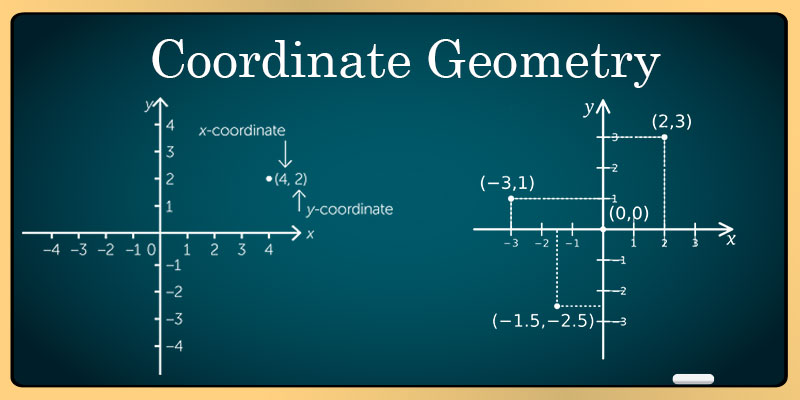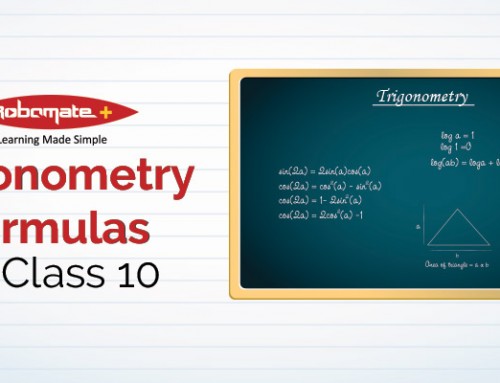1. If the point A (x , y) is equidistant from B (4 , 2) and C (-2 , 4). Find the relation between x and y.
|AB| = (x−5)2+(y−1)2−−−−−−−−−−−−−−−√
= x2+16−8x+y2+4−4y−−−−−−−−−−−−−−−−−−−−−√
|AC| = (x+2)2+(y−5)2−−−−−−−−−−−−−−−√
= x2+4+4x+y2+16−8y−−−−−−−−−−−−−−−−−−−−−√
Since, |AB| = |AC|
⇒ x2+y2−8x−4y+20 = x2+y2+4x−8y+20
⇒ 8y – 4y = 4x + 8x
⇒ y = 3x
2. Find the perimeter of a triangle with vertices (0, 8), (0, 0) and (6, 0)
Let the vertices of the △ be P(0, 8), Q(0, 0) and R(6, 0)
∴ PQ = (0)2+(−8)2−−−−−−−−−−√=64−−√=8
∴ QR = (6)2+(0)2−−−−−−−−−√=36−−√=6
∴ RP = (−6)2+(8)2−−−−−−−−−−√=100−−−√=10
∴ Perimeter of △ = 8 + 6 + 10 = 24 units
3.Find the coordinates of the perpendicular bisector of the line segment joining the points P (1, 4) and Q (2, 3), cuts the y-axis.
Here, O (0, y), P (1, 4) and Q (2, 3)
AO = BO
⇒ (0−1)2+(y−4)2−−−−−−−−−−−−−−−√ = (0−2)2+(y−3)2−−−−−−−−−−−−−−−√
⇒ 1+y2+16−8y=4+y2+9−6y
⇒ 8y – 6y = 17 -13
⇒ 2y = 4
y = 2
∴The required point is (0, 2)
4. The points which divides the line segment joining the points (5, 8) and (1, 2) in ratio 1:2 internally lies in which quadrant?
Now C(1+103,2+163)
∴ C(113,6)

Since, C(113,6) lies in IV quadrant.
5. If A (x2,3) is the mid-point of the line segment joining the points B(4,1) and C(8,7). Find the value of x.
∴4+82=a2
⇒ 24 = 2a
⇒ a = 12
6. A line intersects the y-axis at point A and B respectively. If (3, 4) is the mid-point of AB. Find the coordinates of A and B.
Here, x+02=3 ⇒x=6
0+y2=4 ⇒x=8

∴ The coordinates of A and B are (0, 8) and (6, 0).
7. Find the fourth vertex S of a parallelogram PQRS whose three vertices are P (-3, 8), Q (5, 4) and R (6, 2).
Here, −3+62=5+x2⇒x=−1
8+22=4+x2⇒x=3
∴The fourth vertices S of a parallelogram PQRS is S(-1, 3)
8. Find the coordinates of the point which is equidistant from the three vertices of the
△POQ.

Point equidistant from the three vertices of a right angle triangle is the mid-point of hypotenuse.
⇒(4x+02,0+4y2)⇒(2x,2y)
9. Find the area of a triangle with vertices (x, y + z), (y, z + x) and (z, x + y).
Area of the required
△=12|x(z+x−x−y)+y(x+y−y−z)+(y+z−z−x)|
= 12|x(z−y)+y(x−z)+z(y−a)|
= 12|0| = 0.
10. Find the area of a triangle with vertices P (2, 0), Q (6, 0) and R (5, 4)
Area of the required △PQR
= 12|2(0–2)+6(4–0)+5(0–0)|
= 12|24−4|=10 Sq. units.
11. If the points O (0, 0), P (3, 4), Q (x, y) are collinear, then write the relation between x and y.
Since, O (0, 0), P (3, 4), Q (x, y) are collinear.
⇒ Area of a triangle formed by these points vanishes
∴ 12|0(4–y)+3(y−0)+x(0−4)|=0
⇒y−2x=0⇒2x=y
12. Find the coordinates of the point O dividing the line segment joining the point P (6, 5)
and Q(2, 10) in the ratio 2:1.

x=2(2)+1(6)5=4+65=2
and y=2(10)+1(5)5=20+55=5
∴ O(2, 5)
13. The line joining A(4, 3) and B(-3, 6) meets y-axis at C. At what ratio dose C divides the line segment AB?
Since,R lies on y-axis, let C be (0, y)

Suppose that the required ratio be z:1
∴x=−3z+4z+1⇒0=−3z+4⇒z=43
∴ The required ratio is 4 : 3.












